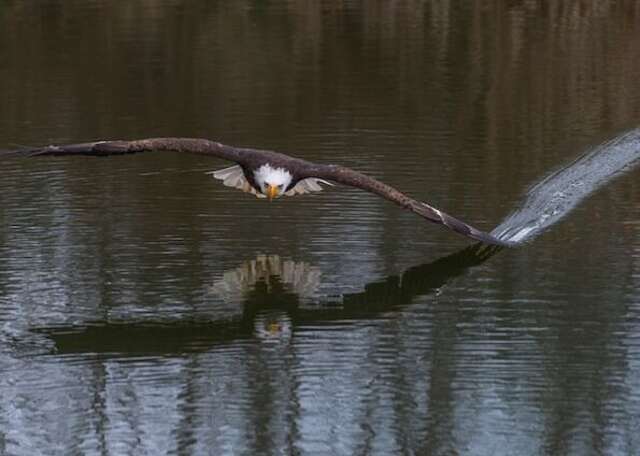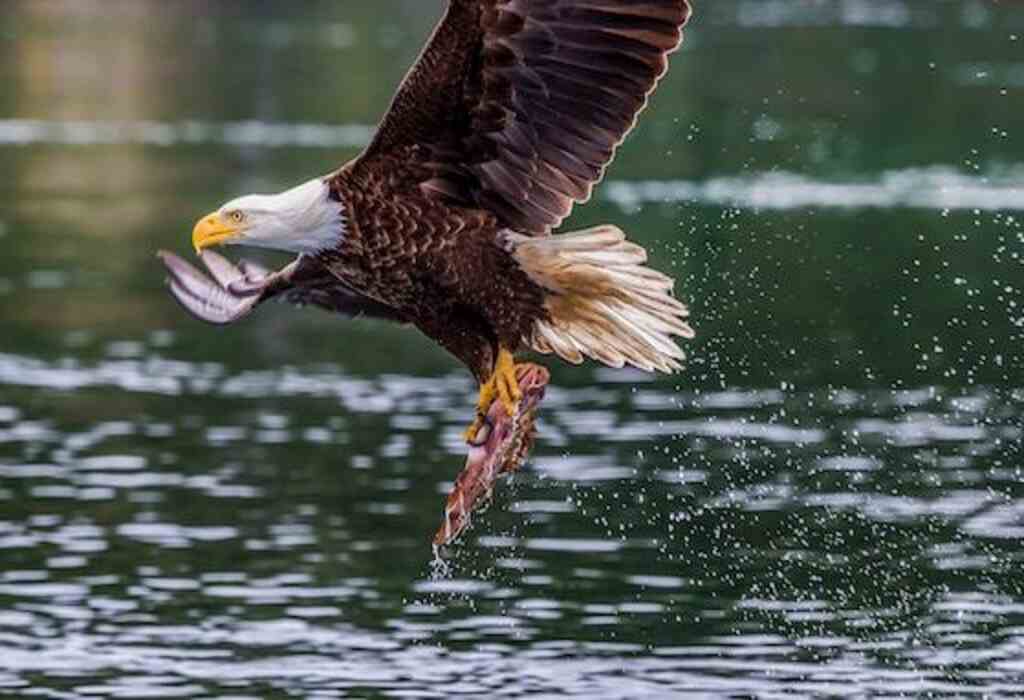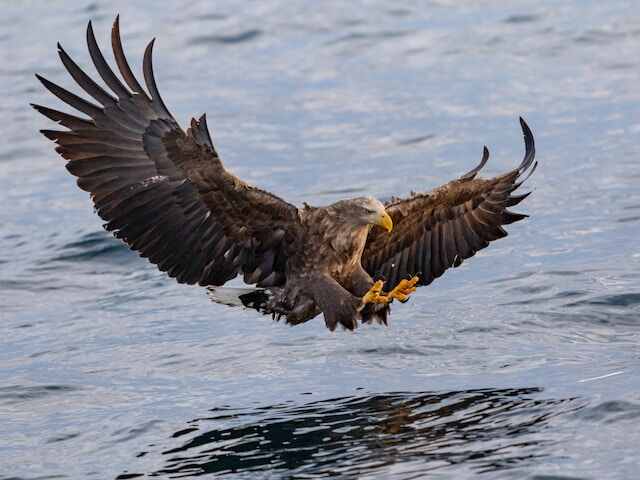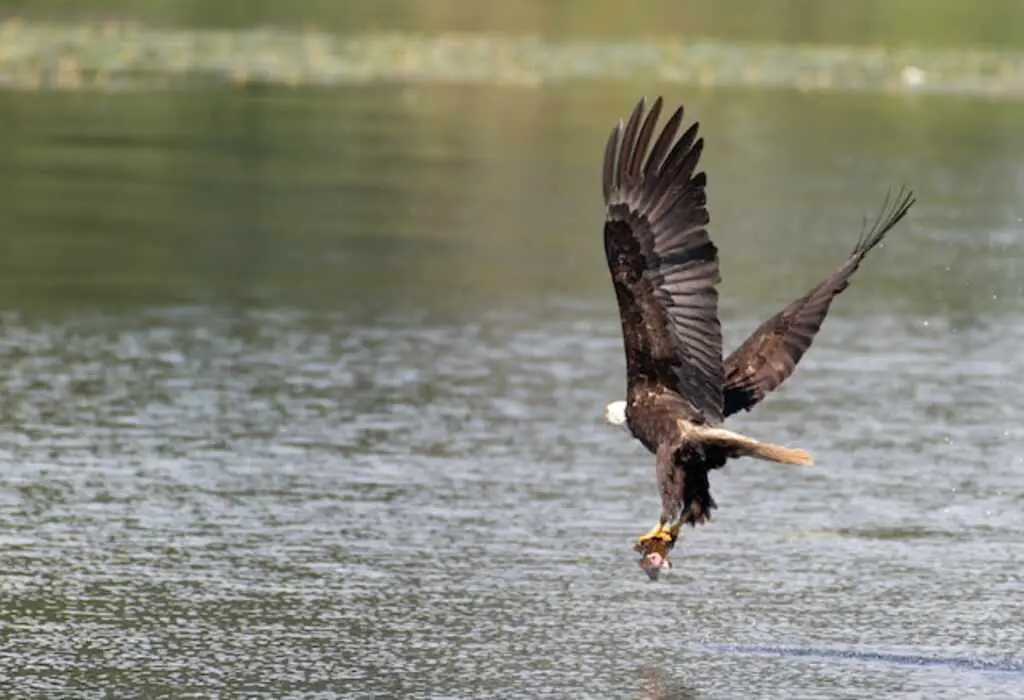Do Eagles Eat Fish? Delve into the soaring world of our majestic feathered hunters! Amidst their awe-inspiring flight and piercing gaze, lies a lesser-known truth: eagles have a penchant for fish.
Explore the remarkable relationship between predator and prey, uncover unique hunting techniques, preferred fish species, and the environmental factors that shape their piscivorous lifestyle.
Get ready to dive deep into their aquatic adventures!
Table of Contents
- 1 Key Takeaways
- 2 Do Eagles Eat Fish
- 3 Types of Eagles that Eat Fish
- 4 Hunting Techniques of Fish-Eating Eagles
- 5 Adaptations for Catching and Eating Fish
- 6 Preferred Fish Species for Eagles
- 7 Frequency of Fish in Eagle Diets
- 8 Geographic Distribution of Fish-Eating Eagles
- 9 Competition and Interactions with Other Fish-Eating Birds
- 10 Impact of Environmental Factors on Eagle Fishing Success
- 11 Conservation Considerations for Fish-Eating Eagles
- 12 Myths and Misconceptions about Eagles and Fish
- 13 Frequently Asked Questions
- 14 Conclusion
- 15 Author
Key Takeaways
- Fish-eating eagles have various adaptations and hunting techniques that enable them to catch and eat fish.
- The preferred fish species for eagles depend on their geographic location and habitat.
- Environmental factors such as pollution and climate change can impact the success of eagle fishing endeavors.
- Conservation efforts should focus on protecting habitats and maintaining prey availability for fish-eating eagles.

Do Eagles Eat Fish
Yes, eagles do eat fish. These majestic birds of prey have a strong affinity for fish, and their diet often includes various aquatic species. Eagles are known for their impressive hunting skills and sharp talons, which they use to snatch fish from the water’s surface or even dive into the water to catch their slippery prey. Their piscivorous nature showcases their adaptability to different ecosystems and makes them formidable hunters in their aerial domain.
Types of Eagles that Eat Fish
Various species of eagles, such as the bald eagle (Haliaeetus leucocephalus), osprey (Pandion haliaetus), and white-bellied sea eagle (Haliaeetus leucogaster), are known for their remarkable ability to catch and consume fish as a significant part of their diet.
These types of fish-eating eagles exhibit distinct fishing behaviors that enable them to successfully catch their prey.
For instance, the bald eagle is known for its hunting technique called ‘plucking,’ where it swoops down from a high vantage point and snatches fish from the water’s surface with its sharp talons.
On the other hand, the osprey employs a unique method known as ‘diving,’ where it hovers above the water before diving headfirst to snatch fish with its powerful claws.
Additionally, the white-bellied sea eagle uses a similar technique, diving from great heights to grab fish.
Understanding the different fishing behaviors of these eagles provides valuable insights into their hunting techniques, which will be explored in the subsequent section.
Hunting Techniques of Fish-Eating Eagles
Fish-eating eagles employ a variety of hunting techniques, such as aerial swooping, hovering, and plunge diving, to secure their prey. These techniques allow them to effectively catch fish in different environments and maximize their chances of success.
- Aerial swooping: Eagles will soar high in the sky and then rapidly descend towards the water surface, using their sharp talons to snatch fish from the water.
- Hovering: Some eagles, like the Osprey, hover in mid-air before diving feet-first into the water to catch fish.
- Plunge diving: This technique involves the eagle diving headfirst into the water, using its powerful wings to propel itself underwater in pursuit of prey.
- Perch hunting: Certain species of fish-eating eagles prefer to perch near the water’s edge and patiently wait for an opportunity to catch fish that come close to the surface.
These hunting techniques allow fish-eating eagles to target their preferred fish species and adapt their strategies accordingly.
In the subsequent section, we will explore the fascinating adaptations these eagles possess for catching and eating fish.
Adaptations for Catching and Eating Fish
Adaptations in the morphology and behavior of these aerial predators enable them to successfully capture and consume their piscine prey.
Fish-eating eagles possess several adaptations that aid them in their hunting techniques and feeding behavior. One such adaptation is their sharp, curved beak, which allows them to grasp and hold onto slippery fish.
Their strong, muscular legs and sharp talons also play a crucial role in catching fish, as they provide a secure grip and enable the eagles to snatch their prey from the water’s surface.
Furthermore, these eagles have excellent eyesight, which enables them to spot fish from high altitudes and target their dives accurately.
Their long, broad wings and aerodynamic bodies facilitate swift and precise movements during the hunting process.
These adaptations allow fish-eating eagles to excel in their pursuit of aquatic prey, ensuring their survival.
Transitioning to the subsequent section, the preferred fish species for eagles vary depending on their geographical location and habitat.

Preferred Fish Species for Eagles
The preferred piscine prey for eagles is primarily determined by their geographic location and habitat, with specific species being selected based on availability and suitability.
Eagles have a diverse diet, but fish make up a significant portion of their food intake. Their fish preferences vary depending on the region they inhabit.
For example, in coastal areas, eagles may feed on marine species such as salmon, herring, and trout. Inland eagles may target freshwater fish like catfish, perch, and carp.
The selection of fish species is influenced by factors such as water depth, temperature, and the presence of suitable prey.
Eagles have developed specialized adaptations, such as sharp talons and a keen sense of sight, to facilitate their successful hunting of fish.
Understanding the eagle’s fish preferences provides valuable insights into their ecology and behavior.
Transitioning into the subsequent section about the frequency of fish in eagle diets, it is important to examine the abundance and availability of fish species.
Frequency of Fish in Eagle Diets
One notable statistic regarding the frequency of fish in eagle diets is that in a study conducted in the Pacific Northwest, fish accounted for over 70% of the prey items consumed by bald eagles.
This high fish consumption by eagles has significant ecological implications and highlights the importance of fish as a primary food source for these majestic birds.
Understanding the dietary diversity of eagles is crucial for assessing the health of their populations and the overall health of aquatic ecosystems.
Additionally, studying eagle fish interactions, including predation rates and foraging behavior, provides valuable insights into the dynamics of predator-prey relationships and the role eagles play in shaping their environment.
This knowledge can help guide conservation efforts and inform management strategies to maintain healthy fish populations and preserve the habitats that support fish-eating eagles.
Transitioning into the subsequent section about the geographic distribution of fish-eating eagles, it is essential to explore how eagles adapt to different environments and the factors that influence their distribution.
Geographic Distribution of Fish-Eating Eagles
Geographic distribution plays a crucial role in determining the habitats where fish-eating eagles can thrive and the availability of suitable prey for their sustenance.
Fish-eating eagles are found in various regions around the world, with their distribution often influenced by factors such as climate, water availability, and food abundance.
For example, bald eagles (Haliaeetus leucocephalus) are primarily found in North America, where they inhabit a wide range of aquatic habitats including coastal areas, lakes, and rivers.
Similarly, the white-bellied sea eagle (Haliaeetus leucogaster) is commonly found in coastal regions of Australia, Southeast Asia, and the Indian subcontinent.
In contrast, the African fish eagle (Haliaeetus vocifer) is mainly found near freshwater bodies across sub-Saharan Africa.
Understanding the preferred habitats and geographic distribution of fish-eating eagles is essential for conservation efforts and ensuring their survival.
This knowledge can also provide insights into their interactions and competition with other fish-eating birds.
Competition and Interactions with Other Fish-Eating Birds
Interactions among various avian species that rely on fish as their primary food source often occur in habitats where these birds coexist.
Competition among fish eating birds can be intense, as they compete for limited resources and territories. This competition can have various effects on the population dynamics and behavior of these birds.
For example, larger and more dominant species like eagles may outcompete smaller species for access to prime fishing spots and prey.
Additionally, pollution can have detrimental effects on fish populations, which in turn can impact fish eating birds.
Contaminated water bodies may lead to reduced fish abundance or the accumulation of toxins in fish, affecting the health and reproductive success of fish eating birds.
These factors highlight the complex dynamics and challenges faced by fish eating birds in their natural habitats.
Transitioning into the subsequent section about the impact of environmental factors on eagle fishing success, it is important to understand how external factors can influence the ability of eagles to catch fish.

Impact of Environmental Factors on Eagle Fishing Success
Environmental factors greatly influence the success of eagle fishing, impacting their ability to secure sustenance and survive in their natural habitats.
One significant environmental factor that affects eagle fishing success is water pollution.
High levels of pollution in aquatic ecosystems can lead to a decrease in fish populations, affecting the availability of prey for eagles.
Additionally, polluted water can also have detrimental effects on the health of fish, making them less suitable as a food source for eagles.
Another important environmental factor is climate change.
Rising temperatures and changing precipitation patterns can alter the distribution and abundance of fish species, making it more challenging for eagles to find suitable prey.
Furthermore, climate change can also impact the timing of fish migrations, potentially disrupting the eagles’ feeding patterns.
Considering these factors, it is crucial to address conservation considerations for fish-eating eagles to ensure their survival and the maintenance of healthy ecosystems.
Conservation Considerations for Fish-Eating Eagles
Conservation efforts must prioritize the protection of the natural habitats and prey availability for fish-eating eagles, ensuring the sustainability of these majestic predators and the preservation of the delicate ecosystems they inhabit.
To address the conservation challenges faced by fish-eating eagles, it is crucial to consider the impact of human activities on their habitats.
Four key factors to consider include:
- Habitat destruction: Human activities such as deforestation and urbanization can lead to the loss or degradation of the eagles’ nesting and foraging habitats, affecting their ability to find fish.
- Pollution: The contamination of water bodies with pollutants, such as pesticides and heavy metals, can accumulate in the fish that eagles rely on as their primary food source. This can lead to negative health effects and reduced reproductive success.
- Overfishing: Excessive fishing practices can deplete fish populations, reducing the availability of prey for the eagles. Sustainable fishing practices should be implemented to maintain a healthy balance.
- Climate change: Rising temperatures and altered rainfall patterns can impact fish populations and disrupt the eagles’ foraging patterns. Conservation efforts should consider the long-term effects of climate change on fish availability.
Addressing these conservation challenges is essential to ensure the survival of fish-eating eagles and the ecosystems they depend on.
Transitioning to the subsequent section about myths and misconceptions about eagles and fish, it is important to clarify common misconceptions regarding their feeding habits.
Myths and Misconceptions about Eagles and Fish
One common misconception surrounding the dietary habits of fish-eating eagles is that they solely rely on aquatic prey for sustenance.
While it is true that fish make up a significant portion of their diet, fish-eating eagles are not limited to consuming only fish.
They are opportunistic predators and also feed on a variety of other prey, including small mammals, birds, and carrion.
This misconception may arise from the fact that fish are a readily available and easily accessible food source for eagles, especially those that inhabit areas near bodies of water.
However, they are not exclusively dependent on fish and can adapt their diet based on the availability of prey in their habitat.
It is important to dispel this myth and recognize the versatility of fish-eating eagles in their feeding habits.

Frequently Asked Questions
How do fish-eating eagles adapt to catch and eat fish?
Fish-eating eagles have developed various fishing techniques to catch and consume fish. Their hunting behavior is greatly influenced by the availability of fish, which affects their foraging strategies and habitat selection.
What are the preferred fish species for eagles?
Eagles prefer various fish species as their primary prey, employing their exceptional hunting techniques in specific fishing habitats. Understanding the intricate relationship between eagles and their favored fish species enhances our knowledge of these majestic birds.
How frequently do fish make up the diets of eagles?
Fish make up a significant portion of the eagle’s diet, with various species preferred. Eagle fishing techniques involve swooping down to catch fish with their sharp talons. However, pollution can negatively impact fish availability and thus affect the frequency of fish consumption by eagles.
Where are fish-eating eagles found geographically?
Fish-eating eagles are found in various geographic regions, including North America, Europe, Asia, and Africa. Their migration patterns are influenced by factors such as food availability and breeding behavior. Conservation efforts aim to protect their habitats and ensure healthy fish populations for their survival.
How do environmental factors impact eagle fishing success?
Environmental factors such as water clarity significantly influence eagle fishing success. Reduced clarity can hinder their ability to spot and catch fish. Additionally, human fishing activities can disrupt eagle foraging patterns, affecting their access to prey.

Conclusion
In conclusion, this comprehensive study delves into the intriguing world of fish-eating eagles.
By exploring various aspects such as the types of eagles that consume fish, their hunting techniques, adaptations, preferred fish species, and dietary frequency, we gain a deep understanding of their ecological role.
We also examine the competition and interactions with other fish-eating birds, the impact of environmental factors on their fishing success, and the importance of conservation efforts.
By dispelling myths and misconceptions, we foster a greater appreciation for these magnificent creatures and their vital contribution to aquatic ecosystems.



